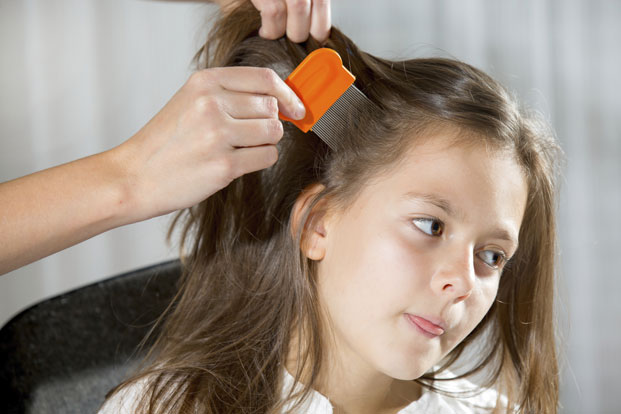Parents with kids in school dread that almost inevitable letter that will arrive at some point. It’s a notification that one or more students in the school have become infected with head lice.
The immediate reaction from someone who has no experience with lice is panic. They will want to know whether their child is infected, whether they came in contact with the children who did have lice, and whether there are any dreaded bugs coming home. Should the children’s hats and clothes be burned? Should we visit the doctor and get some atomic antiseptic? Are the household’s cleanliness standards up to par?
The best advice is to calm down. Lice isn’t leprosy, and it’s fairly common among school kids. The head louse is a wingless, tiny parasite that lives in human hair and feeds on small amounts of blood sucked from the scalp. Lice is the plural of louse, and they are contagious, hard to get rid of and above all, annoying. But don’t panic.
Ultimately, anyone who has lice will be back to normal in short order with the proper treatment. It’s not time to fumigate the house, shave anyone’s head or apply all sorts of chemical treatments to the family.
The Good News: Lice Aren’t Dangerous
The good news is that a lice infestation isn’t dangerous. The creatures don’t spread disease, although they can cause scratching, which increases the potential for infections if the skin is penetrated. Lice on a child’s head are visible with the naked eye. They can be yellow, tan or brown dots before hatching and usually are located near the root line of hair shafts, particularly in long-haired individuals. Lice love warmth, and they will cling to the hair shafts tightly, which makes them impossible to remove by mere brushing or other techniques.
You will usually discover nits rather than live lice crawling around; the eggs take up to two weeks to hatch once they are laid. After that, the shells remain and look white on the hair root. Adult lice are about the size of watermelon seeds and are usually tan or white. Nymphs are smaller, and if not cleaned away, they will lay eggs continuously every three weeks.
When removing lice, be careful to dispose of them properly. They can survive for two days once removed from the scalp and have the potential to return to the nearest source of blood and warmth, i.e., another family member.
How To Avoid Lice
Because lice are easily transmitted from person to person, they can spread quickly, which is why schools send out a notice to every parent. Other common gatherings like childcare, nursing homes, sporting activities and camps are particularly susceptible to breakouts.
Lice are mainly spread via head or hair contact. That means if a child shares a hat with an infected person, then he or she may pick them up. Here are four tips to prevent potential lice transferral to your child.
1) Avoid sharing brushes or combs – Children often swap these grooming utensils. Tell your child to avoid borrowing or lending combs or brushes to others. It’s not impolite and potentially will save your child from getting lice.
2) No trading clothing – Again, children love to swap. Tell them sharing a hat or even a t-shirt may lead to an unwanted lice infestation. Remind them that it’s OK to say no.
3) Avoid selfie close-ups – Kids often put their heads together to capture the perfect moment of bonding via a cell phone selfie. Tell them that it’s not wise to have head-to-head contact in those situations.
4) Keep hair clean – It’s a good idea to clean hair daily to avoid problems before they happen.
Also to be avoided: sharing a bed or even lying side by side on the grass at nap time. The good news: Pets can’t transmit lice to people, nor can they get lice from you. So there’s no need to shave Fluffy if your child comes home with a lice letter.
How to Treat Lice
The best method for dealing with lice is using a medicated shampoo, lotion or cream rinse designed to kill them where they lay. These can be obtained at a drugstore or through a doctor’s prescription. Most medications will kill lice and remaining nits, but it may take a few days for it to work and during that time, your child may still itch and scratch. In severe cases, a doctor may recommend an oral medication that will kill lice in combination with medicated shampoos.
Make sure that any over-the-counter products are age appropriate. Many medicated shampoos are recommended for children age 2 and older. Carefully follow the directions – these are somewhat powerful medications that needs to be administered with care. Moreover, optimal results are achieved when the products are used exactly as directed. Medicated shampoos and other direct applications are usually followed by gently combing nits out with a fine-tooth comb.
It may be necessary to remove any nits by hand in extremely young children. Use a magnifying glass and a bright light to illuminate the child’s scalp, then use a fine-toothed comb on a wet, conditioned scalp every three to four days. A regular comb will do – don’t believe the hype surrounding electric combs or other devices that claim to kill lice. Keep repeating the procedures for several weeks to ensure the child is louse-free.
Kids don’t have to be banned from school during a lice outbreak. In previous years, doctors recommended they stay at home until officially cleared for re-entry. Now children can return to school the next day if they’re undergoing treatment but should be reminded about avoiding head-to-head contact and sharing hats.
While annoying, lice are just one of those things that need to be dealt with in school and other organizations. You and your family will get through it, and it shouldn’t require any massive lifestyle changes.

Leave a Reply